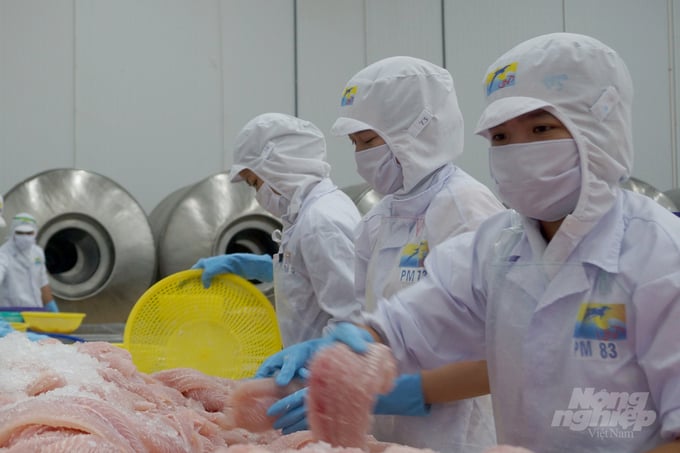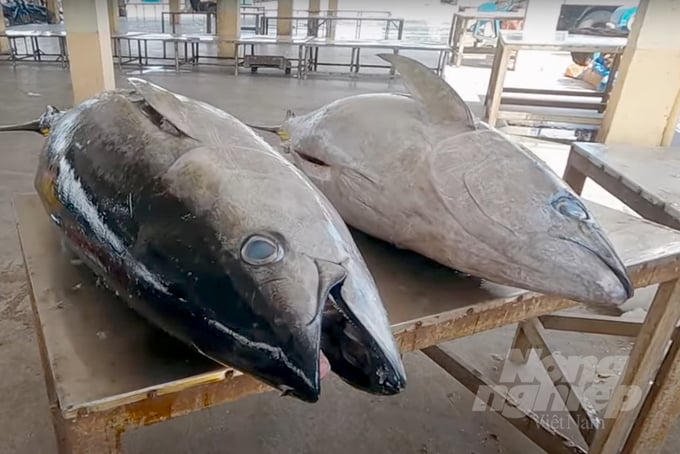November 26, 2025 | 10:36 GMT +7
November 26, 2025 | 10:36 GMT +7
Hotline: 0913.378.918
November 26, 2025 | 10:36 GMT +7
Hotline: 0913.378.918

Vietnam's pangasius exports to the EU in 2022 increased sharply thanks to the EVFTA Agreement. Photo: Thanh Son.
The new generation of free trade agreements have benefitted Vietnam's seafood exports immensely in 2022.
According to Ms. Le Hang, Deputy Director of VASEP.PRO Center under the Vietnam Association of Seafood Exporters and Producers VASEP: Although Vietnam's seafood export is still significantly affected by IUU "yellow card", the export value to the EU market for the first 9 months of 2022 retained a strong growth and reached approximately 1 billion USD; this is an increase of 40% compared to the same period in 2021. It is projected that seafood exports to the EU will reach 1.3 billion USD by the end of the year.
Despite the high inflation rate in the EU, seafood exports to this market grew steadily because seafood businesses have made good use of market opportunities as well as tariff preferences in the EVFTA Agreement.
Pangasius exports have proved that seafood businesses have taken advantage of market opportunities as well as tax incentives. Data compiled by VASEP shows that pangasius exports to the EU reached 122 million USD, an increase of 91% compared to the same period in 2021. This figure is higher compared to value of pangasius exports to the EU for the entirety of 2021 at 106 million USD.
The EU market's shortage of white fish due to the embargo on Russian seafood, the largest supplier of white fish to the EU, has opened up a excellent opportunity for Vietnamese pangasius. This opportunity is accentuated even further thanks to the preferential tariffs for Vietnamese pangasius imports into the EU.
Ms. Nguyen Thi Hoang Thuy, Vietnam Trade Counselor in Sweden, said that Vietnam is currently dominating pangasius imports to the European market. Vietnam's pangasius has not encountered other notable competitors in this market.
Most pangasius products exported to Northern Europe originate from Vietnam. As a result, the EVFTA Agreement, effective from August 1, 2020, is creating a great opportunity for Vietnamese pangasius to enter the European market, especially when pangasius products are taxed at the 0% level according to the 3-year roadmap.

Vietnamese tuna exports to the EU are benefiting from competitive advantages offered by the EVFTA Agreement. Photo: Thanh Son.
Vietnamese tuna exports to the EU are benefiting from competitive advantages offered by the EVFTA Agreement. According to VASEP, after a decline in the second quarter, tuna exports to the EU in the third quarter recovered strongly and increased by 47% over the same period in 2021, reaching 47 million USD.
One of the reasons for this growth is reported to be the fact that interntional markets are preparing for the peak season at the year-end holidays, during which the supply of tuna to the EU market from the East Pacific region is reduced as a result of the 12-day veda embargo.
The EU aims to increase tuna imports from Asia because the price is more competitive compared to Manta tuna from Ecuador. Among other tuna exporting countries in Asia, Vietnamese tuna has been more competitive than that of the Philippines, Indonesia or Thai thanks to the EVFTA Agreement.
On the other hand, Vietnam's seafood exports are also experiencing impressive growth thanks to various tariff incentives under the CPTPP. According to VASEP's assessment, effective utilization of the CPTPP Agreement is subjectively better compared to the EVFTA because the CPTPP Agreement is more open towards seafood and the Agreement is not subject to other related restrictions such as the IUU yellow card.
There are 3 markets under CPTPP among the top 10 largest single markets of Vietnamese seafood this year, including: Japan, Canada and Australia; all of which have experienced strong growth. Namely, in the first 9 months of 2022: seafood exports to Japan reached 1,266 billion USD, an increase of 32.8% over the same period in 2021; seafood exports to Canada reached 311 million USD, an increase of 66.2%; seafood exports to Australia reached 276 million USD, an increase of 52.5%.
According to the Import-Export Department under the Ministry of Industry and Trade, seafood export is expected to slow down when the global inflation state is increasingly severe for the remainder of 2022. High prices has caused the demand for seafood imports from the US, the largest market for Vietnamese seafood, to drop. Although inflation in the EU has reached a record level, the EVFTA agreement will be an important factor in improving the competitiveness of Vietnamese seafood products in this market.
Translated by Nguyen Hai Long

(VAN) An Giang promotes supply-demand connections, standardizes quality and builds value chains, creating a foundation for sustainable bird’s nest development and aiming to expand exports.
/2025/11/24/5339-4-nongnghiep-075331.jpg)
(VAN) Recently, the conference on 'Sustainable Fisheries Linkage Chain - Tilapia for Export' took place in Tien Hai commune, Hung Yen province.
/2025/11/21/4309-2-153400_128.jpg)
(VAN) Green and low-emission rice is paving the way for Vietnamese rice to enter high-end markets, marking the beginning of a transformation journey toward greening and elevating the national rice brand.

(VAN) ‘Right to Win’ outlines a national action plan that shapes a new vision for Viet Nam’s agriculture in an era of renewal and global integration.

(VAN) Lam Dong’s farmed sturgeon output this year is expected to reach 2,300 tons, worth VND 450 billion, affirming the brand’s position on the market.

(VAN) A surge in Ukrainian egg exports, largely driven by soaring sales to the UK over the last few years, has notably pushed up egg prices on the domestic market.

(VAN) The price of Arabica Catimor coffee in Quang Tri is currently at VND 25,000–27,000/kg (fresh cherries), the highest level ever recorded